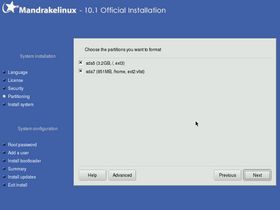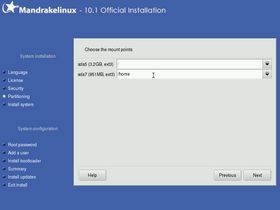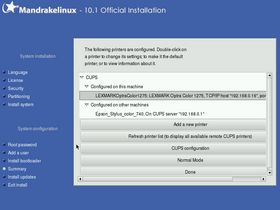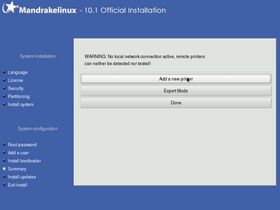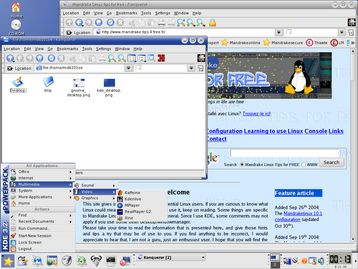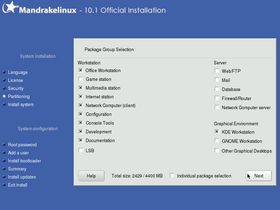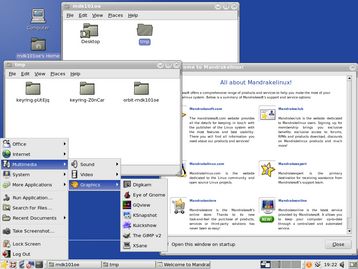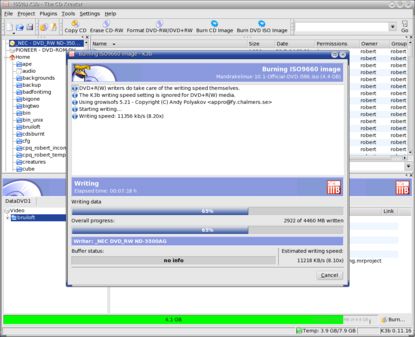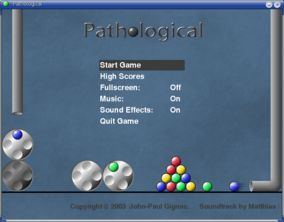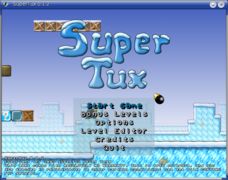In-depth Mandrakelinux 10.1 Official Edition review
Related links
Release notes
Products
Features
Errata
Mandrakelinux development bugtracker Bugzilla
Mandrakelinux stable release bugtracker Anthill
Mandrakeclub
TWiki
www.mandrakeusers.org, one of the best forums for assistance
easyurpmi.zarb.org, the one stop shop for your software installer setup needs
translation teams
my Mandrakelinux 10.1 configuration page
my Mandrakelinux 10.1 installation page
Sites linking to this review
Distrowatch
OSnews
PCLinuxOnline
Mandrakelinux' website
Linux Today
Thanks for linking!
Site news
Latest site additions:
Updated January 13rd 2008:
My LIRC page: The Linux Audio Server Project - Revisited
Added January 3rd 2008:
My (K/X/)Ubuntu review: Ubuntu - beyond the hype
Added December 2nd 2007:
My Mandriva 2008.0 review
Added November 20th 2007:
The configuration page of Mandriva Linux 2008.0
Added November 18th 2007:
The Installation walkthrough of Mandriva Linux 2008.0
Added November 17th 2007:
The review of openSUSE 10.3
Added July 8th 2007:
The Configuration page of Mandriva Linux 2007.1 Spring
Added July 1st 2007:
The Installation walkthrough of Mandriva Linux 2007.1 Spring
Added December 18th 2005:
The third and final part of my Mandriva Linux 2006 review
Added November 14th 2005:
The second part of my Mandriva Linux 2006 review
Added November 6th 2005:
The first part of my Mandriva Linux 2006 review
For older additions please see the articles page.
Features of Mandrakelinux 10.1
- kernel 2.6.8.1-12mdk - improved usb, laptop and wireless support
- urpmi after setup with easyurpmi.zarb.org really great
- drakwizards: Mandrake Control Center, with underlying tools: diskdrake, drakxservices, userdrake, drakTermServ, etcetc
- KDE 3.2 (KDE 3.3 is also available)
- GNOME 2.6
- X.Org 6.7 (X.Org 6.8 is also available)
- OpenOffice.org 1.1.3
- udev (instead of devfs)
- internationalisation - large choice of languages
- the community around Mandrakelinux, friendly to new/inexperienced users (for instance www.mandrakeusers.org)
- an amazing amount of available packages/programs
See also MandrakeSoft's features page and Distrowatch.
Introduction
For this review I went out of my way and installed on all systems I could get my hands on. This should give a much better overall impression of the capabilities of the tested operating system than when it just gets tested with 1 or 2 systems. What few people realise when reading a review, is that their experience might well be different due to differences in hardware.
On one hand the reviewer may have gotten bad luck with his particular setup, and may have run into issues that others would have never come across - but they may just never even try, based on a negative review. On the other hand, the reviewer may have found no issues (remember the LG deaddrive issue? MandrakeSoft testers even had one of those, just not with the affected firmware), whereas other hardware might prove to be a lot more problematic.
Testing on a large variety by no means guarantees anything, a limited selection of hardware can never be fully representative for all hardware out there, but the general relevance goes up with every extra device tested.
On a side note, all images are clickable to get the full size versions.
Software used for testing
I have used the Silver Member DVD (Powerpack) for the systems in this review, on the hardware as in the hardware section below. For the curious I have created a file with the dvd contents.
Harware used for testing
Here's a short list of the most interesting hardware in the machines used for testing, to give you an idea.
Name | type | CPU type/speed | RAM | motherboard/chipset | video | audio | remarks
zurich | desktop | athon 2400+ 2GHz | 1024MB | Asus A7V333/KT333 | MSI geforce4 ti4200 | audigy2 | see sysspec.html
samos | laptop | PIII 650MHz | 384MB| Compaq | ATI rage pro mobility | onboard audio | Compaq Armada M700, see sysspec.html
neuchatel | desktop | duron 1000MHz | 384MB | KinetiZ T7/KT133 | geforce 2mx | onboard audio | see sysspec.html
dell1 | desktop | P4 2.4GHz | 512MB | Dell | Intel 845 | Intel i810 | Dell Optiplex GX240 on an external usb drive
dell2 | desktop | P4 2.6GHz | 512MB | Dell | Intel 865 | Intel i810 | Dell Optiplex GX260 on an external usb drive
moon | laptop | P-M 1.5 GHz | 512MB | Samsung | ATI Radeon Mobility M9 | onboard audio (intel) | Samsung P30 Centrino laptop
gandalf | desktop | PIII 800MHz | 512MB | Intel 815 based | Radeon 7200 | SB Live! | Dell XPS-Z
Installation
The installation on dell2 was non-graphical, as was found out due to an issue with the bios - the bootprocess screen is also non-graphical, and to start a graphical session the 855patch was necessary. dell1 didn't exhibit these problems, though it has in the past (Mandrakelinux 10.0 OE), apparently the bios upgrade to version A05 has helped to fix the issue.
Furthermore, the installation on the external usb drive is problematic in the sense that newly created ext3 partitions couldn't be formatted and were seen as vfat:ext2 partitions.
The workaround there was to boot from dvd into the rescue mode, then use fdisk to create the partitions and mke2fs to format them. During the installation the choice had to be 'use existing partitions' and the proposed formatting of the / partition had to be turned off. The initial installation attempts and formatting were done on dell2, but the final installation was done on dell1 (without partitioning and formatting). There was no other reason for doing the installation on dell1 than that dell2 wasn't available at the moment I had more time to continue the initial installation, by all means the installer worked fine (apart from the usb drive related issues).
The usb drive was the only one that got a fresh /home partition, all other systems reused existing user accounts, that were properly detected during installation. It seems the installer just checks the top level directory names on the /home partition, I happen to have quite a mess there, with extra directories of things I don't want to put on the root (/) directory since that one may at some point get wiped.
System moon, the Samsung laptop, wouldn't read the dvd+r so I had to reburn the iso on a dvd-rw disc. I don't know if this has anything to do with bitsetting, but for a dvd-burner/reader from last year, I'd expect it to read dvd+r(w) discs without problem. Thumbs down for this Samsung laptop.
All other systems installed without anything special to note, which can be considered very good.
I do have a hint for those who have network printers (standalone or on cups servers) - first do the network card setup (see the left image what you get if you don't), then at the printer configuration dialog the installer actually finds the cups printers and you can set up the network printer too (image on the right).
By the way, some nice features of the installer:
hitting ctrl-alt-del during installation (I did this at the point of selection of partitions to be used for installation) brings you back to the first step: Language selection.
At the step of individual package selection there is a hidden search function, which comes in really handy when browsing the flat list: just start typing and the package name you type is presented to you. Cool!
Lastly, I can't stress this enough, if you are at the step of partitioning a drive, and you can spare some 4 to 6GB (which is quite likely on any recent system, considering the current hard drive sizes), do yourself a favour and create an extra, spare partition for future use as root (/) partition of some alternative system (until that time, just choose mountpoint /mnt/altroot or so). This may be a future alpha/beta/rc/ce version of Mandrakelinux, or some other Linux distribution that you may want to try out. Or who knows, maybe you want to give one of the BSD flavours a try.
It's good to keep your options open, and there are so many messages on all related forums of people who installed a new system, squarely on top of their old-but-nicely-set-up-and-working systems, who would actually like to go back - but they can't since the new system has replaced the old one.
Naturally such a spare partition means you'll be able to see how things were set up in that old-but-nicely-set-up-and-working system.
And if you have such a spare partition to serve as root partition, you can easily take part in beta (and rc/CE) testing. In any case, with the current rate of development in the Free(dom) Software world, it is very likely that you're going to want to install some other/new system within the next 12 months.
Configuration
The boot and shutdown processes are graphical, with a nice progress bar (except on dell2 due to the bios issues, and samos where I set things up during installation in the summary - bootloader configuration step to have more rows/cols on my consoles).
After booting a clean login screen (mdkkdm) is presented with pictogram icons for each user. No root login for a graphical session is available - unless you know how to change the login manager to offer it, in which case you likely know the associated risks.
On neuchatel the Mandrakelinux 10.1 CE was updated to OE (all other systems received a fresh installation - updating from older systems than 10.1CE is somewhat tricky due to the shift from devfs to udev, but it can certainly be done); this went well, except for the nvidia module not having been installed. Understandable, since it never was installed with the Mandrakelinux 10.1 CE rpm, I had followed the traditional installation process as per instructions on the NVidia website (see my nvidia installation page). The existing /etc/X11/xorg.conf file was automatically adapted to use the nv driver instead of the nvidia driver, so the graphics were functional. With the software installer the NVidia driver was painlessly installed, unfortunatly the 'nv' indication in the xorg.conf file was not automatically changed into 'nvidia', so I had to do that by hand.
On zurich the configuration issues were related to some drivers, notably pwc (that I rebuilt to have vga resolution instead of stamp size qcif or whatever it is) and the LIRC drivers. The latter are simply absent due to broken code in the kernel source - the code is there but the drivers don't get built. These too I have rebuilt (actually from the code in the 2.6.7 multimedia kernel) for the regular 2.6.8.1-12mdk kernel. Find those drivers and instructions on how to use them on my configuration page.
System moon happens to have a broken DSDT table. Sadly, even the newer BIOS that was loaded onto the system some weeks ago didn't bring any relief, the Samsung engineers missed their chance to correct the error. Without a kernel recompile this laptop has no acpi functionality, and without that, amongst other things, no cpu throttling - sorely needed for acceptable battery life (and yes, mkinitrd --dsdt was tried, but the laptop still wouldn't boot, so the kernel rebuilding was really necessary). With a rebuilt kernel (2.6.9) it now works fine, but the 3d graphics are no longer accellerated. The Mandrakelinux installer had correctly detected the graphics adapter and installed the driver, and it seems everything, including onboard firewire, wireless (everything could be configured, but due to a lack of a wireless network it couldn't be tested), softmodem, etc, was working properly. The only issue that showed up was that the mouse wasn't working - but after rebooting with a ps/2 and a usb mouse, they were all working and hotpluggable. The touchpad had been working all along. Due to the need to rebuild the kernel, all drivers that didn't come with the kernel from kernel.org (wireless, ATI graphics driver, softmodem) have to be redone to get back the functionality of the clean installation. All in all this laptop cannot be recommended for Linux users - and due to the 'bad' dvd drive, incapable of reading standard dvd+r discs, maybe not even to Windows users. Thumbs down for this hardware.
System gandalf had some remarkable issues after boot: the newly created /etc/xorg.conf file wasn't working properly. Maybe the fglx driver isn't the right one for the ATI Radeon 7200 card, or something else went wrong, in any case, substituting the xorg.conf with the one from the Mandrakelinux 10.1 CE partition (told you, it's great to have more than one partition to use as root partition ;-) did the trick.
On neuchatel, samos, dell1, in terms of hardware configuration, there was practically nothing left to do after installation. On samos klaptop had to be configured to use the powerfeatures (cpu clock throttling, lid close event, etc).
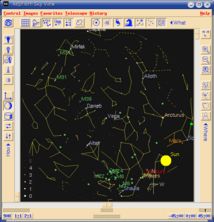 One of the most important things is to properly setup the software installation tool
One of the most important things is to properly setup the software installation tool urpmi, which is done in 3 simple steps through easyurpmi. Once this is done, an enormous amount of additional software becomes available, from multimedia applications to games to great astronomy programs (such as Xephem) and mathmatical programs (such as matlab-compatible octave and its extensions). With urpmi or its graphical front-end RPMdrake (Mandrakelinux Control Center => Software Management => Software Installation), each of these programs can easily be installed, including any packages that they depend on. RPMdrake features nice search capabilities to easily find a program if you know what it should do for you but don't know its name. After installation of programs with graphical interfaces, a menu entry shows up automagically in the related menu.
However, the installation of some packages will give a bad-signature error, for instance:
# urpmi hddtemp
The following packages have bad signatures:
/mnt/mdk101oedvd/media/contrib/hddtemp-0.3-0.beta11.1mdk.i586.rpm: Invalid Key ID ((sha1) dsa sha1 md5 gpg GPG#70771ff3 OK)
Do you want to continue installation ? (y/N)
I know that this is not a big thing, but it will confuse novice users, and it should not happen - in the long run, malware targetting Linux may actually stand a chance if people get used to ignoring such warnings and installing anyway.
As a final remark, java and flash were already installed, no extra steps were necessary. Here the Mandrakelinux Powerpack scores more points on the scale of convenience.
Hardware support and issues
On samos, hibernate (suspend to disk) works fine, but sleep (suspend to ram) doesn't - it goes to sleep, but doesn't wake up anymore. The automatic cpu frequency throttling through cpufreqd also doesn't do its thing, although I may have to do some more fiddling in that area. The tv-out doesn't work, and 3d graphics accelleration is absent for the moment (I saw in some X.org file that they do plan on integrating the 3d driver part with the regular X.org code tree). I had to get and compile a driver for the built-in LTmodem.
Kernel 2.6.8.1 normally doesn't allow to burn discs with K3B as a regular user, but luckily the Mandrakelinux kernel has been patched. It also seems that kernel 2.6 now allows (at least) 1GB without having to get a 'up4GB' kernel (I have not tested any systems with more than 1GB of RAM memory).
USB works fine now, my external usb harddrive functions fine as usb-removable-storage and as system drive.
Previously, supermount was used, which led to issues with read speed (see my 9.2 review), so mounting had to be done by hand for fast transfers. Now this has been fixed, the system behaves as if external storage is mounted by hand. The nice thing about this is that it can be unmounted (to be sure you can disconnect without file system corruption) and the drive space information shows up when using 'df -h'. System gandalf did have some usb harddrive mounting issues. It seems that the USB drive's partitions cannot be mounted properly due to drakupdate_fstab trying to mount the extended partition (/dev/sda4), and since that can't be mounted it fails at mounting all partitions.
My multi-card-reader works fine, except for one thing: if I don't disconnect it but just take out the memory card or insert another one, this doesn't get seen by the kernel (I monitored with tail -f /var/log/messages), so no device (/dev/sd__) is created, which makes it quite impossible to use the device. Unplugging the card-reader completely works fine, so I have no issues, but I do wonder how built in cardreaders are supposed to be used. I noticed that starting harddrake2 sometimes helps, but it takes several minutes in these usb cases to do its thing - not nice.
 A bug related to a conflict between usb audio and pci audio (which led to non-functioning internal audio - only the usb audio was seen, and if you have a webcam that's just a microphone), that I first reported during the betatesting of Mandrakelinux 10.0 has finally been fixed (at least for me), so now it shows both audio devices neatly.
Another improvement is with the mixer settings - first they followed the standard practice to set all mixer controls to zero, which is actually technically good, but too many users didn't understand it. Then the user feedback led to the choice of putting mixer controls at 50%. This gave issues with acoustic feedback, especially many laptop users complained about a shrill wistle - due to the microphone input control not being set to zero... As they say, 3rd time's a charm, so now this too works fine.
A bug related to a conflict between usb audio and pci audio (which led to non-functioning internal audio - only the usb audio was seen, and if you have a webcam that's just a microphone), that I first reported during the betatesting of Mandrakelinux 10.0 has finally been fixed (at least for me), so now it shows both audio devices neatly.
Another improvement is with the mixer settings - first they followed the standard practice to set all mixer controls to zero, which is actually technically good, but too many users didn't understand it. Then the user feedback led to the choice of putting mixer controls at 50%. This gave issues with acoustic feedback, especially many laptop users complained about a shrill wistle - due to the microphone input control not being set to zero... As they say, 3rd time's a charm, so now this too works fine.
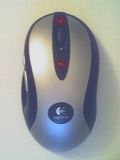 The Logitech MX700 mouse's thumb buttons work fine, provided imwheel is installed and properly set up. See my configuration page on how to do that. However, there are still some issues with this type of multi button mice. This mouse has two buttons to simulate continued scrolling, and the one for scrolling up starts out by giving one 'forward' button (well, actually 'button 6' according to
The Logitech MX700 mouse's thumb buttons work fine, provided imwheel is installed and properly set up. See my configuration page on how to do that. However, there are still some issues with this type of multi button mice. This mouse has two buttons to simulate continued scrolling, and the one for scrolling up starts out by giving one 'forward' button (well, actually 'button 6' according to xev, urpmi X11R6-contrib to install xev) event, then starts scrolling up ('button 4' events as long as it's pressed). If you have not browsed further (i.e. if you haven't gone 'back'), you may not notice, but after some 'back' action and scrolling down, the button to scroll back up will have you end up at the next page, instead of at the top of the one you're reading.
There is one button high on top of this mouse, which passes the same event (button 1) as the left mouse button... (see picture I coloured the problematic buttons red - 2 out of 9 if you count the wheel as 3, not too bad but no perfect score either.)
Ok, I know, it's not placed in any usable way, but I don't see why on other operating systems this button should have a shadow of a usability feature due to being bindable to some arbitrary function, and not having any extra use on Linux...
Or maybe I'm just searching for things to complain about. And yes, in case you're wondering, what I mention here is indeed all I've been able to find to nag about.
So all in all it can be said that Linux' hardware support has really improved a lot - one of the two systems that didn't have working graphics after installation is hampered with some BIOS issues, which a new BIOS would likely fix, the other one was easily fixed too, albeit due to an experienced user. All network cards were detected properly, as were all audio cards, mice, etc.
Even if Linux may offer hardware support out of the box at a level that no other system comes close to, it still pays off to invest some time when buying hardware, and check if it is properly supported under Linux: do a websearch, ask the salesman (yes, sometimes they actually know, and if they don't but say it will work you can bring the device back if it doesn't), ask on forums, etc.
Software: plenty of it, improved or completely new
There are basically two camps in the ongoing discussion about choice in the Linux/Free Software world: the Nay-sayers complain that there are too many choices - which just confuse people, especially new and inexperienced users. Their worry is that the abundance of choice slows down the widescale adoption of Linux on the desktop. On the other side of the 'software choice' debate we find the Yay-sayers that want to have the choice to use whatever application they want, and who find it important to have competing projects - after all, competition is what drives innovation and quality - at least, the contrary of this statement is easily found to be true by looking at any software from monopolist software houses. These Yay-sayers argue that Linux distributions should reduce any novice confusion by offering sane defaults.
This is the path that Mandrakelinux is walking. I'm a KDE user,
and on Mandrakelinux, KDE is the default:
and as you can see GNOME won't even get installed by default. And on KDE, which boasts so many options for the most intricate of DE/WM settings that no sane person will actually use all of them, the defaults are chosen as a common denominator to be usable by all - it takes me less than 5 minutes to change these defaults to have me feel at home - but I use a combination of settings that few probably do. Even if you install GNOME and all other desktop environments and window managers that come bundled with Mandrakelinux, if you login without explicitly choosing something else, you just get KDE.
Similarly, XSane doesn't get installed unless you select it, the default program to use for scanning is Kooka. So to please the Nay-sayers, Mandrakelinux has defaults that reduce the amount of unwanted and confusing choices that a novice might face, whereas it does come with one of the largest precompiled software bases, after properly setting up urpmi all packages are installable at the click of a mousebutton or a single urpmi command.
Speaking of GNOME, I gave it a look and must say, as a KDE user they won't win me over just yet, but it is a very appealing desktop environment, and I can see why it has a large userbase. It is definitely a great asset to the Linux desktop, and like KDE it has come a very long way in a relatively short time.
I actually do use quite a few applications that are usually said to be GNOME applications (they're actually just Gtk+ applications), that have a KDE counterpart. Examples: GQview, Evolution, XSane. Naturally, this mix and match of programs with Gtk+ and Qt widgets, file dialogs and buttons doesn't make for a streamlined desktop, and Nay-sayers often claim that such a patchwork desktop is unacceptable. But let's be realistic, although the use of all these different widgets and dialog boxes may well be less visually consistent, it never hampered widescale adoption of MSWindows (which has quite a few different toolkits from MS alone), so there are no grounds to claim that they will really prohibit Linux adoption.
One of the star applications of KDE, K3B, is even greater than before (and they fixed a bug that wouldn't let dvd+r's get burnt at the highest possible speed the drive and media combination was capable of). I know it actually says the selected burn speed doesn't matter when burning dvds, but it sure does.
I know people who prefer K3B over any other burn program, including Nero. I can't really comment, since I haven't used Nero.
OpenOffice.org (OOo)now has a dialog for the first start of each component, that asks if you wish the default 'save' document format to be the MSOffice format or the OpenOffice.org format.
As for OOo's compatibility and interoperability with MSOffice documents, it's still not perfect (it will be once MSOffice starts using a document format that is fully specified). It has certainly gotten better, to the point where it's better at reading MSOffice documents than a different version of MSOffice. Not only are there forward/backward compatibility issues between MSOffice 97, 2000 and XP, but also between the same versions on PC and Mac. As a closing remark on this subject I'd like to add that MSOffice is not at all capable to properly import OOo documents - which should be easy to implement since the document standard is completely open, so OOo is the clear winner in the "who can read who's files" competition.
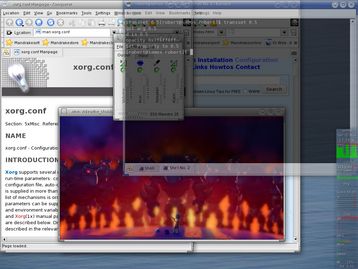 The demise of XFree is already showing to be beneficial to all users: X.Org gets developed at an incredible speed. It seems the only visible 'new' thing that came out of XFree during the last 3 years before the licence change triggered the autodestruct in February 2004 was the translucent mousepointer. In the February/March to October timeframe, X.Org developers have managed to implement graphical coolness such as window shadows and tunable window translucency (see image), and what a screenshot can't show you: menus and windows blending onto and out of the desktop.
The demise of XFree is already showing to be beneficial to all users: X.Org gets developed at an incredible speed. It seems the only visible 'new' thing that came out of XFree during the last 3 years before the licence change triggered the autodestruct in February 2004 was the translucent mousepointer. In the February/March to October timeframe, X.Org developers have managed to implement graphical coolness such as window shadows and tunable window translucency (see image), and what a screenshot can't show you: menus and windows blending onto and out of the desktop.
Under the hood they have improved lots of things too, like the implementation of xdamage and code optimizations for speed. On samos, glxgears normally gave something around 70, now with X.Org 6.8 it does 93 fps. I know, this isn't much, but on this system any speed improvement makes a real difference.
I must say that graphical coolness has it's cost, running xcompmgr on samos brings glxgears' score down to 15 fps...
With a webbrowser connection to a vnc session (as in: http://[hostname]:[5800+displaynumber]), video players (xine, mplayer and any frontend to those) play back in a choppy manner. I tried with X.org 6.8 and this seems to have been fixed too.
In the new Evolution 2.0, Spamassasin has been integrated, which actually led me to believe for a short while that WinXP SP2 was working... I must say that so far over 2 months of use, since Mandrakelinux 10.1 RC1 I have had no false positives (so no non-spam email ending up in the junk folder) and only very few false negatives (spam ending up in my regular inbox) - I would estimage less than 1 in 30 messages. Being one of the more crash prone applications that I use (I generally experience a crash once a week or so) Evolution now exits quite gracefully, with a warning that something went wrong and it asks if it should restart. On a side note, I have never lost any data due to Evolution crashing, or due to any program crashing for that matter.
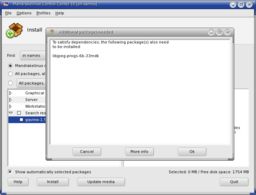 The Drake family has been expanded, for instance with drakroam, a tool for laptop users on the move to keep track of different networks. Numerous draktools have improved, for instance the Mandrakelinux Control Center has a new (actually, more or less reverted to the old) look, and the Software Management tools are now integrated into MCC instead of being opened in their separate window (see image, with an example of the dependency resolution).
The Drake family has been expanded, for instance with drakroam, a tool for laptop users on the move to keep track of different networks. Numerous draktools have improved, for instance the Mandrakelinux Control Center has a new (actually, more or less reverted to the old) look, and the Software Management tools are now integrated into MCC instead of being opened in their separate window (see image, with an example of the dependency resolution).
Small remarks: klipper is not on the tray by default, you have to add it to the panel manually. A new appearance is made by the network monitor on the system tray, for easy network connectivity management, along with an applet for MandrakeOnline, a new MandrakeSoft (paid) service.
On the entertainment side, some golden oldies are still there, such as Tuxracer, Frozen-Bubble and Kgoldrunner (simple but very enjoyable), and some new fun games like Pathological and Supertux.
Naturally, the choice of proprietary pc games for Linux is still limited, the only thing to do there is stop buying games for that other pc platform, and uniquely buy Linux games.
Issues
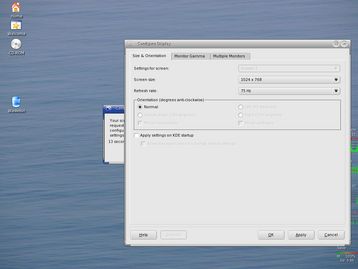 On a new user account, konqueror just wouldn't open. Not by clicking the 'home' icon on the desktop, nor from the command line. In one such case (
On a new user account, konqueror just wouldn't open. Not by clicking the 'home' icon on the desktop, nor from the command line. In one such case (gandalf), after playing with some programs (opening help files), konqueror suddenly worked. In another case (new account on zurich), just logging off and back on helped cure the problem. In some cases of new user accounts however, konqueror worked fine off the bat. Then there have been reports of usb memory sticks not letting konqueror start and even freezing it - I have witnessed one such case on an Armada M700, whereas on samos it worked fine... Anyway, these issues should be solved with the KDE updates that are now on the update mirrors.
Some other weird things that come to mind: neuchatel had a klaptop and blued (bluetooth configuration) instance on the panel - though it has no need for klaptop since it's a desktop system, and it has no bluetooth either.
The resize display confirmation dialog is below the settings dialog, so you have trouble to stop it from reverting to the old settings.
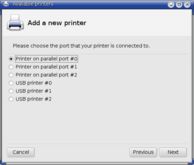
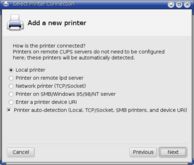
The printer configuration dialogs are great, it's easy to setup a printer. If you don't choose expert mode you only get to setup usb and lp connected printers (image on the left). So to set up a network printer you have to choose 'expert mode' (image on the right) - strange, since you're not necessarily an expert if you have a network printer.
For XMMS users I have another hint: the XMMS entry on the menu is actually soundwrapper xmms instead of plain xmms - sometimes this can be problematic, in the sense that once you click the play button, it just crashes. Drag and drop the button from the menu to the panel, then rightclick and select properties, then choose the application tab, and change the command field from 'soundwrapper xmms' to 'xmms'.
Lastly, the LIRC drivers went missing. Please Mandrakelinux developers, can you fix this bug?
Buy, download, join?
The Powerpack definitely offers a very powerful Linux system, in a very convenient package. There is practically nothing that you can't otherwise get, from software like proprietary graphics drivers and shockwave flash to updates, but if the trouble or effort this saves you is worth your hard earned money is up to you. And please realise that your mileage may vary, in any case it deserves consideration to first try out the download version, and see if your hardware is well supported.
Personally I'm all in favour of the idea to 'try before you buy'. In that respect I see joining the MandrakeClub more as a way to 'tip the waiter' - you don't if you're not satisfied. Living in Europe it's clear that the waiter will still be around since he will get a more or less decent pay to wait on people, so it's better to compare to the situation in the USA, where tipping the waiter is absolutely necessary. If you don't and others don't, the guy may not be around the next time you'd like to enjoy his services. Most people who are not happy after joining the Club or buying a Pack were just expecting too much, like thinking that through their joining or purchase some issues they were having with Linux (hard- or software related) would just suddenly get fixed. This is where I think the analogy with tipping the waiter really works: if something is wrong, you tell the guy, to give him the opportunity to fix things. You can tell MandrakeSoft developers via the Mandrakelinux development bugzilla and the Mandrakelinux stable release bugtracker what things are not properly working yet.
I always considered my joining the MandrakeClub and sending MandrakeSoft my money a way to thank them for the product that they make and that I already had - I only first opened my wallet once I was happy with what I got from them, not a moment before. This is a sure way to avoid any regrets about the money spent.
About the new service of MandrakeSoft, MandrakeOnline, I'm not sure yet what to think. If it's just about updates (like RH up2date), I don't care for that but some may find it handy to have, I can even imagine that for business use such a service is an absolute must.
If you're not going to join the MandrakeClub, nor purchase a Pack, there are other things that you can do to contribute to the Free(dom) Software community - a community that you can join for free - (from low to high level of participation):
- helping people to get started in using it, in real life and on online forums
- reporting bugs and helping out fixing them (by getting the developers additional information, etc)
- translating, writing docs and howto's, adding information to the TWiki's
- actively fixing bugs by going through the code
- writing code, actively developing software
It sure is comfortable on the sideline, but you can really make a difference with your contributions.
Conclusions
Mandrakelinux 10.1 Official Edition is a great Linux distribution. Sure, there are plenty of small things to improve; the missing LIRC drivers, the machines that don't have a graphical interface after installation (one of which due to a 'bad' bios - so only in one case was Mandrakelinux to blame) and the 'konqueror' issues (that are fixed by the recent updates) are annoying, but in the larger scheme of things nothing more than minor glitches. On the other hand, the system installation is easier and smoother than ever before, as is the configuration and maintenance of the system through the Mandrake Control Center and the Draktools.
Properly set up with easyurpmi, urpmi / RPMdrake make selecting and installing packaging incredibly easy, and there is a wealth of software for any and all types of applications: web content and software development, multimedia, server applications, the list goes on.
The installation and maintenance tools, coupled with very good hardware support and the outstanding user community, make Mandrakelinux very attractive as a Linux platform for novice users as well as experienced users who don't want to fiddle with their system any more than necessary.
Lastly I'd like to thank all those who let me mess with their systems in the name of science.
Enjoy Linux!
aRTee
PS Also: enjoy Firefox!
Discussion
You can discuss this article here.
All contents © copyright 2003 - 2007, unless mentioned otherwise, published under the GNU Free Documentation License (FDL) by aRTee. Artwork and CSS don't fall under the FDL, standard copyright applies. Tux image from Larry Ewing. You may use anything published under the FDL on this site freely, as long as you include this copyright notice and a reference to the main address of this site: www.mandrake.tips.4.free.fr.

